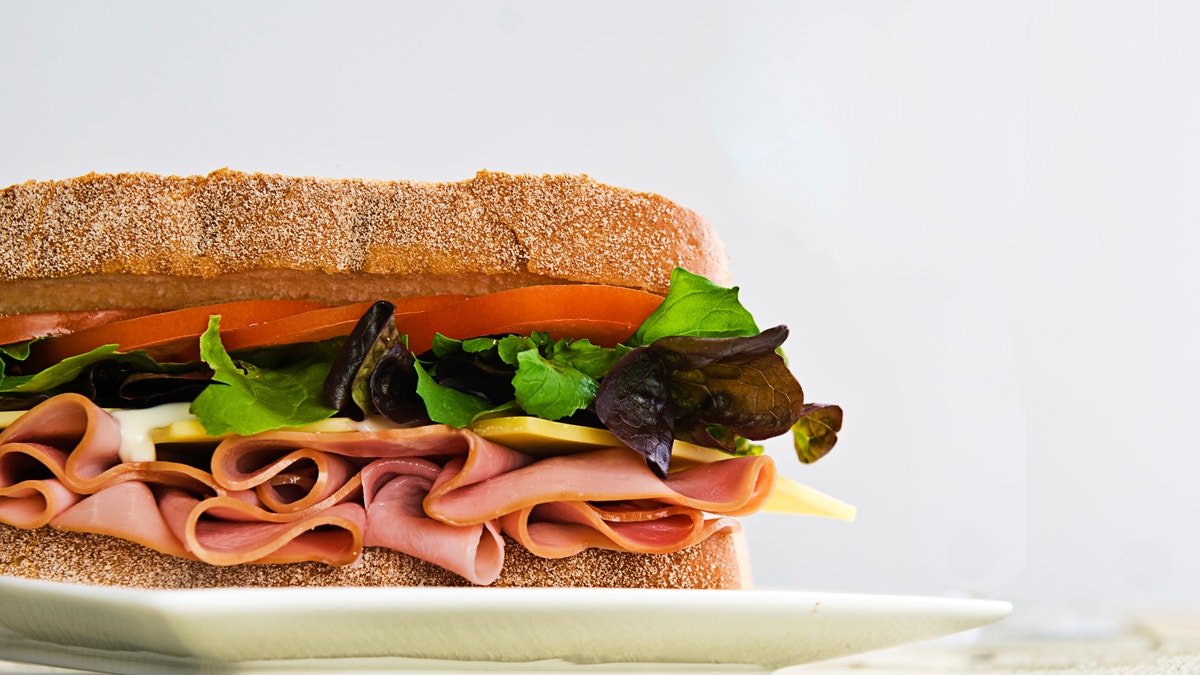
A gourmet sandwich of ham, cheese, lettuce, tomato and mayonaise isolated on white. (Ryan Carter/iStock)
Eating well isn’t always easy, especially when it’s time to separate fact from fiction on food labels at the grocery store.
Food packaging in grocery stores frequently includes the words “gluten-free” or “natural,” signaling that what’s inside is healthy. But do these buzzwords really mean a food is healthy, or is it just advertising?
“The food industry tends to manipulate what is healthy,” says Lon Ben-Asher, a registered dietitian nutritionist with Pritikin Longevity Center & Spa in Miami. The term “natural” has no legal definition, and gluten-free or fat-free foods aren’t necessarily healthier than similar products with gluten or fat.
Food manufacturers often add sugar or salt to enhance flavor when fat is removed to make such products, Ben-Asher says, and these processed versions often have more calories than their full-fat counterparts.
READ MORE: How to Eat Healthy on a Budget
How can you avoid these traps? Stick to whole, natural foods that are hearty as well as healthy, advises Ben-Asher, and limit your consumption of packaged foods. Here are seven cases where you’d be better off saving your money.
1. Quinoa chips
Quinoa is one of the trendiest health foods right now, so it’s not surprising the grain has begun to show up in the form of chips and pastas in grocery aisles. To make quinoa chips, the grain must first be milled into flour, which removes the beneficial fiber and protein; some quinoa chips are baked, but others are fried in oil before salt is added. “So they took a whole grain that has a significant amount of vegetable protein and dietary fiber, and turned it into a highly-addictive, high-calorie food like chips, loaded with salt and fat,” Ben-Asher says.
Try this instead: Have some hummus with fresh vegetables, Ben-Asher advises.
2. Portioned snacks
If you’re trying to lose weight, you probably know portion control is key, but 100-calorie prepackaged snacks offer little in the way of nutrients such as fiber, protein, vitamins and minerals. “These items are usually not as nutrient rich as 100 calories of fruits, vegetables or whole-grain foods,” says Lisa Dierks, a registered dietitian nutritionist with the Mayo Clinic Healthy Living Program. The 100-calorie packages aren’t all bad, but don’t assume that just because a food is low in calories, it’s good for you.
Try this instead: Have a portion of almonds— about 23 of them for 161 calories, Dierks says. The protein and fat will keep you feeling fuller longer than those empty-calorie snacks will.
READ MORE: 7 Reasons to Eat Healthy That Have Nothing to Do With Weight Loss
3. Superfood smoothies
It can be tempting to opt for one of those thick fruit-and-vegetable juices advertised as “superfoods” that usually sit in a cooler near the real fruits and vegetables. But don’t think of them as a substitute for the munchies. “Some of the drinks can average almost 400 calories per 16 ounces, so this is fine if you are missing a meal, but not so great as a snack,” says Dierks.
Try this instead: “Fresh fruits and vegetables are an easy first choice,” Dierks says.
READ MORE: How to Eat More Vegetables
4. Energy bars
By definition, calories are units of energy, and calories may be all you’re getting with many energy bars. While most do contain modest amounts of protein and fiber, they also often contain as much sugar and calories as a candy bar— with less flavor.
Try this instead: Pick up a box of green tea, and sip away during your energy slump.
5. Prepackaged deli meats
A turkey sandwich for lunch always seems like a healthy option, but not when that turkey is loaded with excess sodium, as most deli meats are. Too much sodium can increase your blood pressure and lead to heart disease, so check the levels before you buy. “A low-sodium food, in general, will have fewer micrograms of sodium than calories per serving,” says Robert Vogel, a cardiologist and clinical professor of medicine at the University of Colorado.
Try this instead: Pick up low-sodium varieties of your favorite packaged deli meats, or order directly from the deli counter.
READ MORE: 10 Benefits of Eating Healthy
6. Agave nectar
Agave is often favored by people looking for a healthy alternative to table sugar, but it’s still added sugar, which most of us get too much of anyway. Worse, agave nectar has more calories per teaspoon than table sugar— 21 vs. 16— so if you use it regularly, you’ll really increase your calorie intake. If 5 little calories per day doesn’t sound like much, consider this: Over the course of a year, you could pack on a half-pound of fat from the added sugar of those five calories.
Try this instead: Skip sugar in your coffee and cereal altogether, or cut it in half. Top cereal with fruit to satisfy your sweet tooth.
7. Skim milk
Many people switch from whole milk to skim when trying to cut calories, but current guidelines suggest not going lower than 2%. Milk contains vitamins A, D, and E, which are all fat soluble, meaning they can’t be absorbed without some dietary fat to cling to. Not only does taking out the fat remove some of those vitamins, but the remaining nutrients can’t be absorbed by the body.
Try this instead: Trade your skim milk for 2%.
Food labels can be misleading and confusing. Sticking to simple, whole foods will provide you and your family with the most nutritional benefit. If you do choose a processed or packaged food, check that label carefully: Be sure it’s worth your money— and worth putting in your belly.
